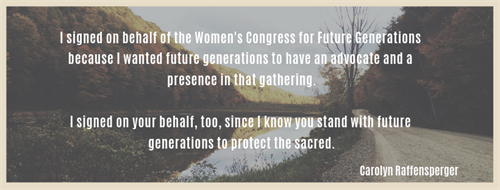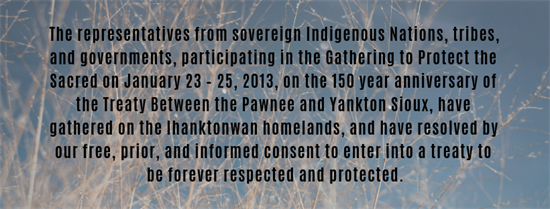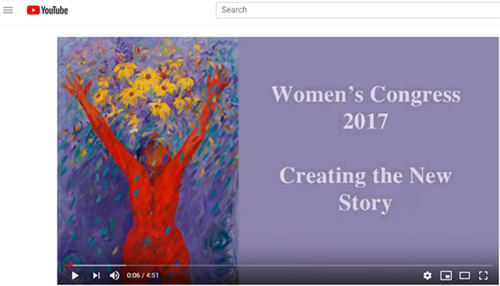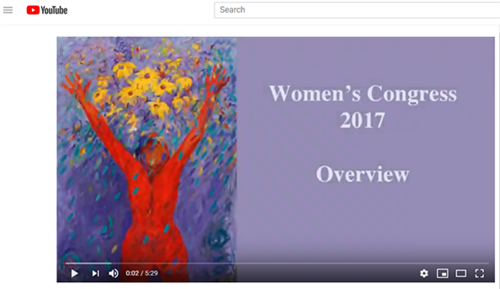|

|

The Signing of a Treaty and
the Beginning of a New Year
Volume 24 (1) January 2019
| " What most amazes me about grassroots groups striving to protect their land, water and communities is their endless creativity and tenacity...The experience the environmental community gained in fighting KXL was put to good use during the struggle against the Dakota Access Pipeline which culminated in the magnificent resistance at Standing Rock. In both KXL and Dakota Access, Indigenous people were the generative force and the leaders in the struggle." |
|
|

|
Friends of SEHN,
Welcome friends to the New Year. 2019 marks the 25th anniversary of the Science and Environmental Health Network. Thank you for all you’ve done over the years to support our work with your generous contributions of time, intellectual gifts and financial donations. We ended the year in a financially sound position, thanks to you. Thank you for all you’ve done in partnership with us. We are more grateful than you know.
We have begun this year with a startling and important event: we are signatories to a treaty called Protecting the Sacred as part of our years-long work with community groups to stop pipelines. Pipeline infrastructure locks us into the use of filthy fossil fuels so that energy companies can get a return on their investment. Fossil fuels increase the inputs of carbon into the environment and pipelines themselves cause permanent damage to land and a constant threat to the waterways they cross. But these pipelines cause harm to human communities because construction is done by large groups of transient men who move into an area for a few months to a year. They are usually housed in large man camps. So not only do we have the environmental damage during pipeline construction but we have increases in drugs and sex trafficking along pipeline construction routes.
What most amazes me about grassroots groups striving to protect their land, water and communities is their endless creativity and tenacity. The struggle against the Keystone XL (KXL) tar sands pipeline has been going on for 11 years. The history of resistance to KXL will go down in environmental history because of the unusual alliances that came together and the extraordinarily creative tactics used to block it. The experience the environmental community gained in fighting KXL was put to good use during the struggle against the Dakota Access Pipeline which culminated in the magnificent resistance at Standing Rock. In both KXL and Dakota Access, Indigenous people were the generative force and the leaders in the struggle.
So how did we end up signing a treaty? Here’s the backstory:
The January 2019 treaty signing on the Yankton Sioux reservation was designed to open the treaty to new signatories and to reaffirm our commitment to protect the sacred and stop this polluting, damaging tar sands pipeline. I was invited to participate and sign because we at SEHN through the Women’s Congress for Future Generations are providing legal and technical expertise to this on-going struggle. Our friend, Faith Spotted Eagle, one of the conveyors of the treaty signing has been instrumental in bringing the wisdom and power of the grandmothers to the table. Some of you may remember her at the last Women’s Congress held in 2017. Video footage can be found here.
I signed on behalf of the Women’s Congress for Future Generations because I wanted future generations to have an advocate and a presence in that gathering. You can see the signing ceremony here: I sign at about 6:30 and Faith speaks right after I sign. I signed on your behalf, too, since I know you stand with future generations to protect the sacred.
Below is the text of the treaty.
Carolyn Raffensperger
Executive Director
|
|
International Treaty to Protect the Sacred from Tar Sands Projects
The representatives from sovereign Indigenous Nations, tribes, and governments, participating in the Gathering to Protect the Sacred on January 23 – 25, 2013, on the 150 year anniversary of the Treaty Between the Pawnee and Yankton Sioux, have gathered on the Ihanktonwan homelands, and have resolved by our free, prior, and informed consent to enter into a treaty to be forever respected and protected. We agreed upon the following articles: READ MORE.
Videos from the Women's Congress for Future Generations
Most of the Midwest is heading into truly frigid temperatures this week – another reminder of the wild climate swings we are now experiencing. The snow-white landscape is beautiful and brings to mind the water ceremony Sharon Day led for us on Friday evening on the opening day of the November 2017 Women’s Congress for Future Generations. It was magical as water, in the form of snow, blessed us all.
We’re excited to share two short videos of the 2017 Women’s Congress. For those you who attended, you’ll find fond memories – and for those who could not, we think you’ll find them healing as we continue to work for a just and sustainable world.
A deep bow of gratitude to Chery Hays-Day and Trudy Dunham. Chery donated her time to video tape all the events in the large convening space at the 2017 Women’s Congress. Trudy and Chery edited the videos to create these short, yet extraordinary reminders of the power of our collective voices. Thank you, Chery and Trudy!
Ann Manning
Women's Congress for Future Generations
|
|
|
|
|
|
|
|
|
|
|
|

SEHN, PO Box 50733, Eugene, OR 97405
|
|
|
|
|
The Science & Environmental Health Network | moreinfo@sehn.org | SEHN.org
|
|











